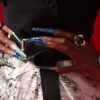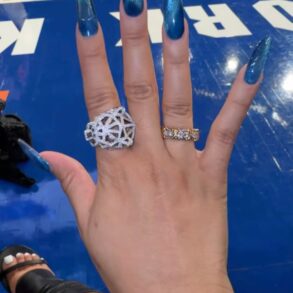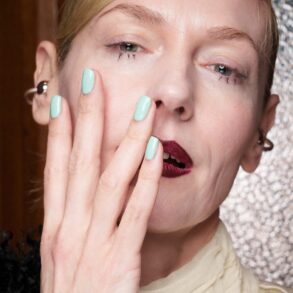Renner is a communications professional and LGBTQ+ advocate. He lives in University Heights.
Over the past ten years, I’ve regularly painted my nails and as a bearded man standing at 6 feet, 2 inches tall, I suppose that’s something unique. One day, I hope it isn’t.
I’ve donned every shade, glitter tone, and have recently been obsessed with elaborate nail art. On my social media, I’ve made a point to post my manicures, my hairy knuckles, and big hands, a stark contrast to typically feminine hands you find under a nails of the day hashtag or #NOTD. For me, this started as a way of defying gender norms, but I’ve stuck with it because it truly gives me joy.
As of late, men painting their nails is in vogue, especially for straight male stars like Bad Bunny and Harry Styles. GQ recently published an article, “Jeremy Allen White Can Pull off a Manicure, and So Can You“. These men are lauded for their self-expression and flare, protected by their straight privilege.
Gay, queer and nonbinary people aren’t always afforded the same praise. So often in entertainment and popular culture, queer people did it first. We should recognize that there is a power dynamic that allows certain aspects of queer culture to be cheery-picked and popularized by the cisgender-heterosexual mainstream.
I started painting my nails when I worked at an LGBT Center in Santa Barbara, where I conducted LGBTQ+ cultural competency trainings for educators and social service providers. I’d explain the difference between gender identity, sexual orientation and gender expression. Having painted nails was an easy way to explain that I identify as a man, am attracted to men and that nail polish was part of my gender expression, which is typically deemed “feminine”.
For the most part, people responded positively to it, after all, I’m affable and carry enough White-passing, tall male privilege that a hint of femininity is generally non-threatening. Women would complement me on my color choices and on occasion, some men would whisper that they liked it too.
My mom didn’t love it at first. “Professional men just don’t wear nail polish,” she would remind me. I worked in a queer space so I knew I could express myself this way, and I figured that might not be possible in other jobs, so I knew I had to enjoy it while I could. It became my signature. My roommate at the time worked for a cosmetics company and would bring home new shades, so our collection grew and grew, eventually we had over 80 polishes.
I religiously wore nail polish from 2013 to 2015 and that really felt cutting edge. The tide for marriage equality was turning and transgender issues were coming up to the mainstream. I got to know more trans people in my community, I was constantly talking about gender politics, and at times, I questioned my own gender identity.
In my trainings, people asked questions, some respectful, many reductive and uncomfortable. What I saw and felt, in that community at least, was a general desire to understand. In many ways, talking about gender identity and expression felt safer then, it wasn’t as charged of a topic and conservatives hadn’t fully latched onto anti-trans rhetoric yet.
When I moved to San Diego, I had to feel out my new environment. When I started various jobs, I’d have to get comfortable before I started donning a manicure at work. When I worked for then-Councilmember Chris Ward in the San Diego City Council District 3 office, I waited a year before I showed up in a suit and painted nails. I didn’t want to be that new staffer to the gay elected official with painted nails; I wanted people to know me before they judged me and my fabulous mani.
Eventually, it just became part of who I am, and my current job affirms my nail polish and all parts of my identity. That too, shouldn’t be something unique.
When it comes to gender expression, I hope that people embrace what makes them feel good and I hope that other people can embrace that. Whatever your identity, wear nail polish, or don’t, you don’t need me, or GQ, or anyone else to give you permission.
This post was originally published on this site be sure to check out more of their content.






